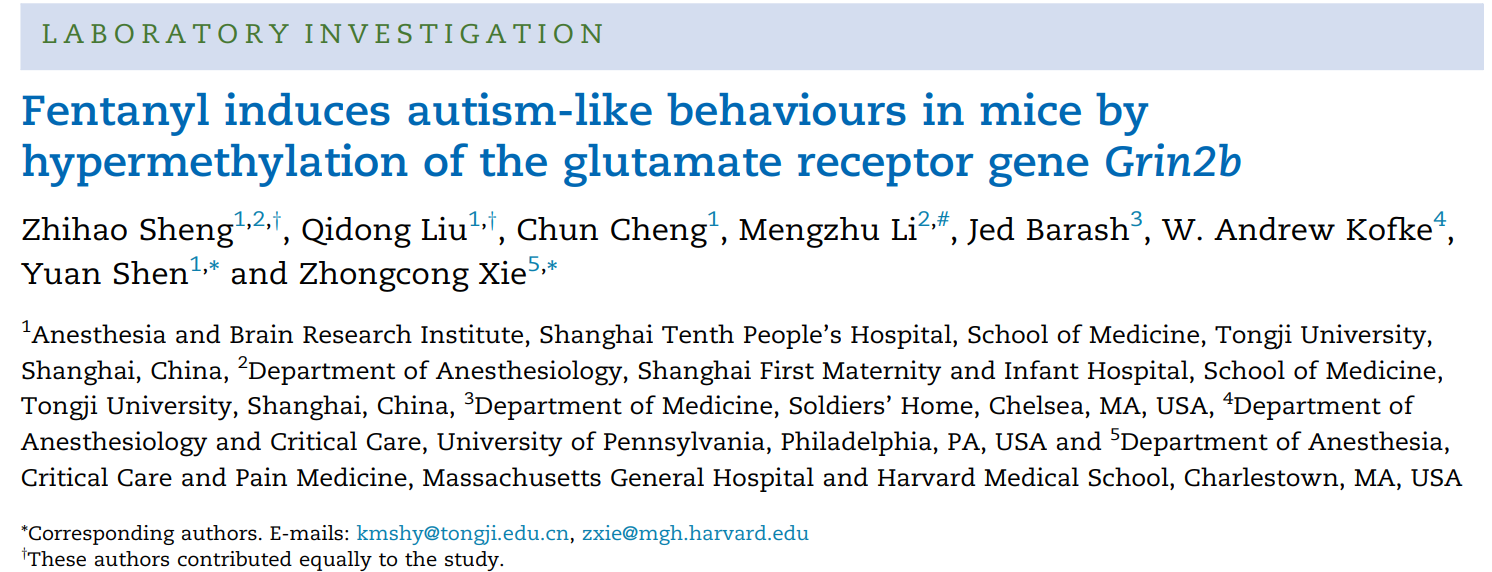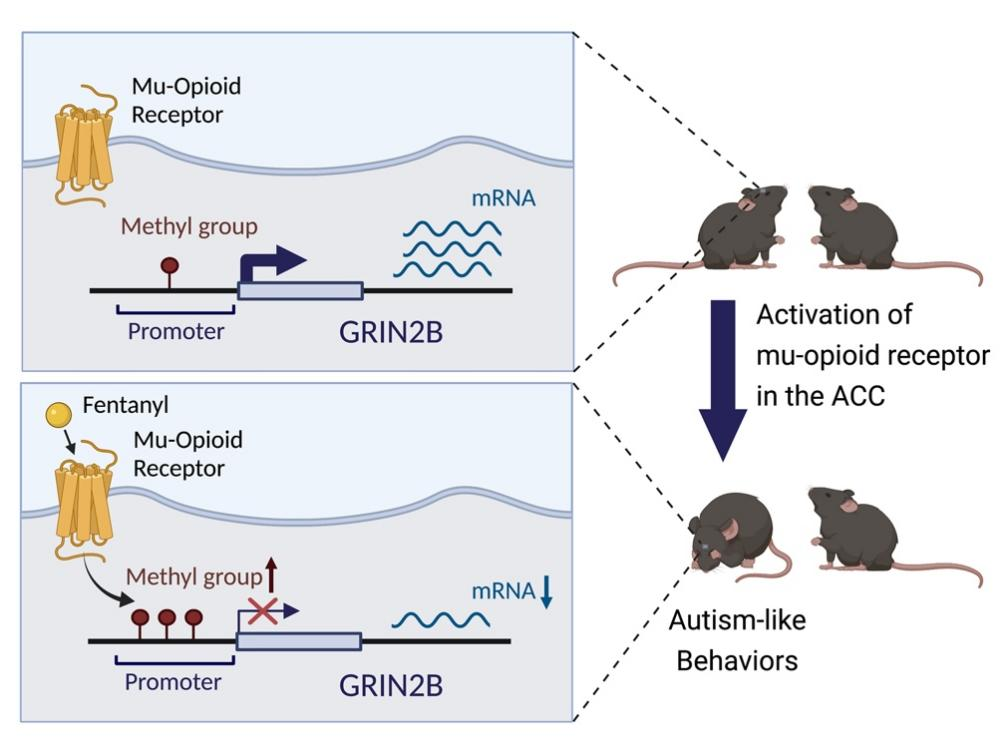On June 14, research team headed by Professor SHEN Yuan, executive deputy director of the Institute of Anesthesiology and Brain of Tongji University’s School of Medicine, research team headed by Professor XIE Zhongcong of Massachusetts General Hospital of Harvard University’s School of Medicine, and researchers from the First Maternal and Child Health Hospital Affiliated to Tongji University, the Soldiers Home in Massachusetts (Chelsea), and the University of Pennsylvania jointly published a research paper entitled "fentanyl induces autism-like behaviors in mice by hypermethylation of the glutamate receptor gene Grin2b" online in the British Journal of Anesthesia, a leading international journal in anesthesiology. This study simulates the process of using opioid analgesics fentanyl in children during multiple anesthesia operations through animal experiments. It is found that fentanyl can induce hypermethylation of the promoter region of Grin2b gene of N-methyl-D-aspartate receptor (NMDAR) in the anterior cingulate cortex (ACC) of young mice by activating mu opioid receptor, resulting in the down-regulation of its mRNA and protein expression, and ultimately lead to autism like behavior in neonatal mice in the long term.

The paper published in British Journal of Anesthesia
Autism spectrum disorder (ASD), also known as autism, is a developmental disease of the nervous system. Its pathogenesis and inducing factors have not been fully clarified. ASD has a high incidence rate, and patients mainly show language and social disorders, stereotyped behavior and anxiety. Because of the onset at childhood, the patient is also known as the "child of stars". Both genetic factors and external environmental factors may cause ASD, and the abnormal expression of important genes in the brain caused by external factors through epigenetic regulation may be one of the main reasons for ASD.
Professor SHEN Yuan's research team and Professor XIE Zhongcong’s research team have long been committed to the impact of anesthesia surgery on brain cognitive functions. Previous studies show that multiple general anesthesia operations will cause damage to children's long-term cognitive functions, but due to the unknown factors during anesthesia operations, the impact of a single anesthetic on children's brain development is not clear. In this study, fentanyl, a commonly used analgesic drug in children's anesthesia surgery, was injected into female and male newborn rats on the 6th day of life (P6), three times every other day (P6, P8, P10), to simulate the analgesic process of children undergoing multiple anesthesia surgery. It was found that the mice treated above showed obvious autism-like behaviors on the 30th day of life. However, mice injected with naloxone, a fentanyl antagonist, did not show autism-like behavior one hour after fentanyl injection. These results suggest that fentanyl may cause long-term autism-like behavior in young mice, and this effect can be reversed by the antagonist naloxone.
Much attention has been paid to the role of the anterior cingulate cortex (ACC) of the brain, as a marginal cortex, in pain and its negative emotions associated with the pain in previous experimental studies. In recent years, studies have found that ACC dysfunction is involved in the pathogenesis of ASD. At the same time, it has also been observed that patients with impaired ACC will have abnormal social behavior, suggesting that ACC plays an important role in individual social behavior. N-methyl-D-aspartate receptor (NMDAR) dysfunction has been widely reported in ASD mice.
The research teams observed the NMDAR in the ACC brain region of young rats, and found that fentanyl, as an opioid analgesic, could cause hypermethylation of the promoter region of Grin2b gene, the subunit of NMDAR in this region of mice, resulting in the down-regulation of the expression of its coding protein GluN2B, by activating the mu opioid receptor in the ACC brain region. The gene expression of Grin1 and Grin2a, other important subunits of NMDAR, was not affected. Researchers injected mu opioid receptor agonist DAMGO into acc stereoscopically on the 6th / 8th / 10th days after birth of the mice to activate mu opioid receptor in this region, which can also induce autism-like behavior on the 30th day and the reduction of Grin2b gene expression in ACC brain region at the same time. The researchers then injected lentivirus into ACC after fentanyl treatment (P10) to overexpress Grin2b, and found that the anxiety and social disorders in the autism-like behavior of mice were significantly alleviated.

By activating mu opioid receptor in ACC, young mice develop autism-like behavior in the long term
This study reveals that multiple exposure to fentanyl causes hypermethylation of the NMDA receptor Grin2b gene and decreases protein expression in this region by activating mu opioid receptor in ACC, resulting in autism-like behavior in young mice in the long term. It should be noted that the results of this study are found in experimental animals. At this stage, there is no evidence that clinical use of fentanyl can lead to the same long-term autism-like behavior in infants.
This study is the first of its kind to find the effect of fentanyl on autism-like behavior in young rats of animals; but there is no clinical study to report that fentanyl has a similar effect in humans. The clinical significance of the study is not clear because the anesthesia operation process is very complex, there are a number of influencing factors, and the individual differences of neonatal neurodevelopment are huge. However, it is expected that the findings of this study will bring about more research in the future to further explore the effects of narcotic analgesics on brain development.
SHENG Zhihao, a doctoral student, and LIU Qidong, an assistant professor, both from the School of Medicine of Tongji University, are the co-first authors of the paper. CHENG Chun, a doctoral student from the School of Medicine of Tongji University, Dr. LI Mengzhu from the First Maternal and Child Health Hospital Affiliated to Tongji University, Professor Jed Barash from the medical department of Soldiers Home in Massachusetts (Chelsea), and Professor Andrew Kofke of the University of Pennsylvania made important contributions to this study. Professor XIE Zhongcong and Professor SHEN Yuan are the co-correspondents of the paper. The study was supported by Professor ZHENG Jialin and Professor XIONG Lize from School of Medicine, Tongji University.
Link to paper: https://www.sciencedirect.com/science/article/pii/S0007091222002392
